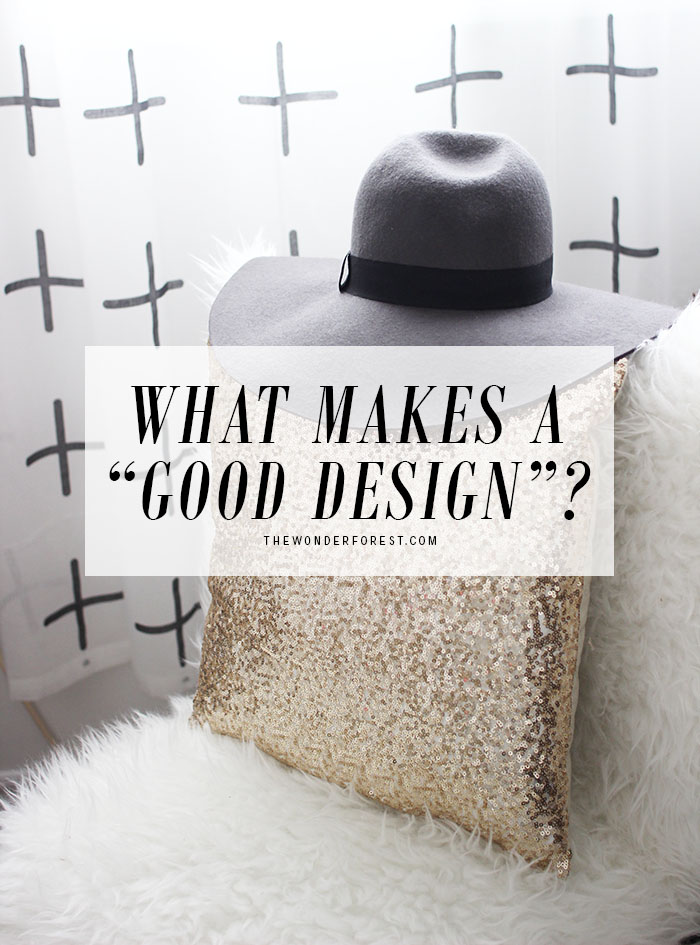Bloggers, business owners, individuals alike all know by now that a good design for their website, blog, marketing materials, and everything else is important. But what really makes a “good design”?
Since not everybody is artistically inclined, the answer could differ greatly. What looks awesome to somebody without an eye for design might look totally wrong to somebody who knows a good layout when they see it. Without causing too much confusion, here are a few things that I believe constitutes a “good design”.
It is visually pleasing.
State the obvious there, why don’t you, Dana? I know, I know. Obviously a good design has to be visually pleasing, but what exactly does that mean?
1. Text and fonts match and suit the brand
I covered this a bit in my post entitled How To Create a Blog Header (That Looks Good!), but I’m going to say it again. Choose fonts that work well together. Just because you love a certain font does not mean it will work for your brand image. Fonts are an important part of design and help convey the overall feel of whatever it is you are trying to market. With such a huge variety of fonts to choose from, you have no excuse for using default system ones!
2. Balance, justification and text is cohesive throughout
The copy on your page or marketing material is an important part of design as well. Always keep in mind the viewer’s experience! We are trained to read from left to right, not from right to left or centered, so thinking about your justification is always a good idea. Does it read easily? The text should flow throughout the design because our eyes don’t like to have to jump all over the place to try to figure out what to read next.
3. Colours compliment one another and aren’t too crazy
I’ve seen some really bad designs that could be highly improved if they took their colour choices into consideration. When in doubt, go back to the colour wheel (or, just check a site like Design Seeds for inspiration!). Most of us learned about colour matching in elementary school, but for those that didn’t, just Google a colour wheel and take a peek. Do a quick read on analogous and complimentary colours as a starting point. There are certain colours that go really well together, and others you should avoid. That doesn’t mean you absolutely have to stick with colour wheel suggestions, but it is a great way to get started and adjust the tones to your needs.
4. White space — leave some
It’s important to let your design breathe. Too many things going on can really make for a bad viewer experience. You don’t want your design to feel congested and white space helps ease that feeling. It also gives each aspect of your design a little more prominence. Spacing between your main content area and your other info is important, and leaving a little room between each “section” is more visually pleasing than if everything is in close quarters. Nobody likes to feel stuffy!
5. It appeals to people
Most of the time, I feel like a good design is just known when you come across it. Why? because it appeals to the senses. It is aesthetically pleasing and easy for your brain to process. The design explains itself and doesn’t require instructions.
6. No details are untouched
Great designs take every little detail into consideration. In the example of a website or blog — input buttons, line separators, links, and all of those little details are designed to match the overall feel of the entire space. The little things really go a long way!
It is functional.
When speaking in terms of your online space, your design has to be functional. Especially if we’re talking about interactive design. A good design does what it is intended to do. It leads the viewer through your space in just the way you had hoped for. This is highly important if you are trying to sell a product or service or trying to get your visitors to interact with you somehow.
Checking your site for errors on various browsers is something that I always recommend you do. Many times I have come across blogs that do not function or display properly in a certain browser, which is never a good thing! Menus and links should all work properly for everyone, and your design should look the same on each.
So you see, there is more to a good design than just having it look pretty! Pretty helps, but you also need to keep your viewers’ experiences in mind!
Last Updated on


This is my take on what is good design.
http://www.cognitiondepot.com/what-is-good-design/